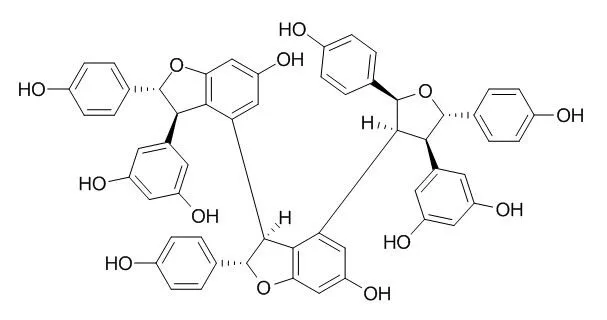| Description: |
Kobophenol A has antimicrobial, and anti-inflammatory activities, it might be a candidate for treatment of inflammatory bone diseases relevant to osteoblast cell death. Kobophenol A inhibits AChE activity in a dose-dependent manner, and the IC50 value is 115.8mM. Kobophenol A has protective effect against nitrosative/oxidative or mitochondrial damages resulted in the inhibition of the ROS, intracellular calcium ion level, and mitochondrial transmembrane potential changes on SH-SY5Y cells.
Kobophenol A, identified through docking studies, is the first compound that inhibits SARS-CoV-2 binding to cells through blocking S1-RBD to the host ACE2 receptor and thus may serve as a good lead compound against COVID-19. |
| In vitro: |
| Int Immunopharmacol. 2013 Nov;17(3):704-13. | | Kobophenol A enhances proliferation of human osteoblast-like cells with activation of the p38 pathway.[Pubmed: 24021754] | Bone cell proliferation, bone formation, and bone resorption are the main factors involved in the homeostasis of the bone mass. Osteoblast death is a problem experienced by postmenopause women. Herbal medicines have attracted considerable attention for use as a drug or a drug substitute in the treatment of bone-related diseases, such as osteoporosis.
METHODS AND RESULTS:
This study investigated the effects of Kobophenol A on the proliferation in human osteoblast cells. Kobophenol A stimulated the proliferation of osteoblast cells by the increases in DNA synthesis and the enhancement of cell cycle progression. Kobophenol A stimulation induced the expression of the cyclin B1 and cyclin-dependent kinase 1 (CDK1). Treatment of osteoblast cells with p38 MAPK inhibitor SB203580 significantly inhibited Kobophenol A-enhanced proliferation. In addition, Kobophenol A induced phosphorylation of p38 MAPK. Treatment of osteoblast cells with Kobophenol A resulted in improvement of ROS scavenging activity. Moreover, Kobophenol A treatment up-regulated the Bcl-2 level, but down-regulated the level of Bax expression. We also demonstrate that Kobophenol A increased alkaline phosphatase (ALP) activity after 2 days.
CONCLUSIONS:
Taken together, the results of this study reveal that Kobophenol A has proliferative effects and enhances ALP activity in osteoblast cells and these findings provide insights into the development of a therapeutic approach of Kobophenol A in the prevention of osteoporosis and other bone disorders. | | Chem Pharm Bull (Tokyo). 2014;62(7):713-8. Epub 2014 Apr 24. | | Kobophenol A inhibits sodium nitroprusside-induced cardiac H9c2 cell death through suppressing activation of JNK and preserving mitochondrial anti-apoptotic Bcl-2 and Mcl-1.[Pubmed: 24759620] | Sodium nitroprusside (SNP) releases nitric oxide (NO), a powerful vasodilator, and thus widely used in intensive care unit for treating hypertension emergency. However, cardiac toxicity after SNP administration is a clinical problem.
METHODS AND RESULTS:
For finding a natural compound that suppressing SNP-induced cardiac toxicity, we tested the protective potential of Kobophenol A (Kob A), purified from the root of Caragana sinica, against the toxic effects of SNP. The severe cardiac H9c2 cell death was induced by SNP (2 mM) treatment. Kob A ameliorated SNP-induced cardiac H9c2 cell death, and this protective effect of Kob A may be related to the inhibition of c-Jun NH2-terminal kinase (JNK) and p38 mitogen-activated protein (MAP) kinase activation following SNP administration. In addition, the downregulation of cellular Bcl-2 and Mcl-1 levels by SNP exposure was strongly abrogated in the presence of Kob A.
CONCLUSIONS:
These biological properties of Kob A might provide insights into developing new cardioprotectant against SNP-induced cardiac cell death. | | J. Phys. Chem. Lett. 2021, 12, 7, 1793–1802 | | Kobophenol A Inhibits Binding of Host ACE2 Receptor with Spike RBD Domain of SARS-CoV-2, a Lead Compound for Blocking COVID-19[Pubmed: 33577324] | | In the search for inhibitors of COVID-19, we have targeted the interaction between the human angiotensin-converting enzyme 2 (ACE2) receptor and the spike receptor binding domain (S1-RBD) of SARS-CoV-2. Virtual screening of a library of natural compounds identified Kobophenol A as a potential inhibitor. Kobophenol A was then found to block the interaction between the ACE2 receptor and S1-RBD in vitro with an IC50 of 1.81 ± 0.04 μM and inhibit SARS-CoV-2 viral infection in cells with an EC50 of 71.6 μM. Blind docking calculations identified two potential binding sites, and molecular dynamics simulations predicted binding free energies of −19.0 ± 4.3 and −24.9 ± 6.9 kcal/mol for Kobophenol A to the spike/ACE2 interface and the ACE2 hydrophobic pocket, respectively. In summary, Kobophenol A, identified through docking studies, is the first compound that inhibits SARS-CoV-2 binding to cells through blocking S1-RBD to the host ACE2 receptor and thus may serve as a good lead compound against COVID-19. |
|






 Cell. 2018 Jan 11;172(1-2):249-261.e12. doi: 10.1016/j.cell.2017.12.019.IF=36.216(2019)
Cell. 2018 Jan 11;172(1-2):249-261.e12. doi: 10.1016/j.cell.2017.12.019.IF=36.216(2019) Cell Metab. 2020 Mar 3;31(3):534-548.e5. doi: 10.1016/j.cmet.2020.01.002.IF=22.415(2019)
Cell Metab. 2020 Mar 3;31(3):534-548.e5. doi: 10.1016/j.cmet.2020.01.002.IF=22.415(2019) Mol Cell. 2017 Nov 16;68(4):673-685.e6. doi: 10.1016/j.molcel.2017.10.022.IF=14.548(2019)
Mol Cell. 2017 Nov 16;68(4):673-685.e6. doi: 10.1016/j.molcel.2017.10.022.IF=14.548(2019)